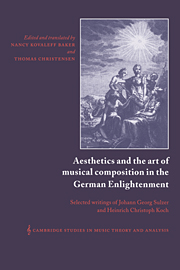 Aesthetics and the Art of Musical Composition in the German Enlightenment
Aesthetics and the Art of Musical Composition in the German Enlightenment Book contents
- Frontmatter
- Contents
- Foreword by Ian Bent
- PART I JOHANN GEORG SULZER GENERAL THEORY OF THE FINE ARTS (1771–74): SELECTED ARTICLES
- Introduction by Thomas Christensen
- I Aesthetic foundations
- II The creative process
- III Musical issues
- PART II HEINRICH CHRISTOPH KOCH INTRODUCTORY ESSAY ON COMPOSITION, VOL. II (1787)
- Index
II - The creative process
Published online by Cambridge University Press: 30 September 2009
- Frontmatter
- Contents
- Foreword by Ian Bent
- PART I JOHANN GEORG SULZER GENERAL THEORY OF THE FINE ARTS (1771–74): SELECTED ARTICLES
- Introduction by Thomas Christensen
- I Aesthetic foundations
- II The creative process
- III Musical issues
- PART II HEINRICH CHRISTOPH KOCH INTRODUCTORY ESSAY ON COMPOSITION, VOL. II (1787)
- Index
Summary
INVENTION [ERFINDUNG] (vol. II, pp. 86–94)
This word is customarily understood in a narrow sense and applied to those things that are universally recognized as having increased knowledge or augmented the arts. Those kinds of inventions that relate to science or commerce are actually less common, and are not of concern here. Instead we are interested in those inventions that make every work of fine art, and even every part of a work, just what it should be. In the most general sense, something is an “invention” so long as it satisfies the intentions of its creator. In the fine arts, every work can be viewed as a tool for arousing certain effects in human temperament. If after considerable reflection and thought the artist is able to create a work appropriate for attaining this intended effect, then the invention is deemed good.
When one speaks of the kind of invention that is demanded of every artist, one really is talking about the thought and the reflection by which he invents those parts of his work that make it what it should be. In this way the speaker will be able to write his speech if, after reflection, he discovers ideas that will be capable of conveying the truth that he wants to demonstrate.
- Type
- Chapter
- Information
- Aesthetics and the Art of Musical Composition in the German EnlightenmentSelected Writings of Johann Georg Sulzer and Heinrich Christoph Koch, pp. 55 - 80Publisher: Cambridge University PressPrint publication year: 1996


